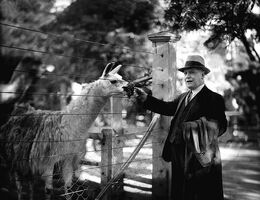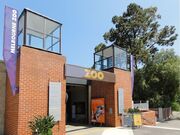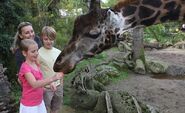The Royal Melbourne Zoological Gardens, commonly known as the Melbourne Zoo, contains more than 320 animal species from Australia and around the world. The zoo is 4 kilometres (2.5 mi) north of the centre of Melbourne. It is accessible via Royal Park station on the Upfield railway line, and is also accessible via tram routes 55 and 19, as well as by bicycle on the Capital City Trail. Bicycles are not allowed inside the zoo itself.
The Royal Melbourne Zoological Gardens is a full institutional member of the Zoo and Aquarium Association (ZAA) and the World Association of Zoos and Aquariums (WAZA).
History[]
Melbourne Zoo is Australia's oldest zoo and was modeled on London Zoo. The zoo was opened on 6 October 1862 at the Royal Park site of 55-acre (22 ha) on land donated by the City of Melbourne. Before this, animals were housed at the botanical gardens in Melbourne.
Initially the zoo was important for the acclimatisation of domestic animals recovering from their long trip to Australia. It was only with the appointment of Albert Alexander Cochrane Le Souef in 1870 that more exotic animals were procured for public display, and the gardens and picnic areas were developed.
Visitors can see historical cages including the heritage listed Elephant House a, which has been renovated and adapted for use for customers paying to sleep overnight in tents at the zoo in popular Roar and Snore evenings. These evenings allow the public to see some of the nocturnal animals at the zoo in evening guided tours by keepers. One of the most famous exhibits was Queenie the elephant.

The President of the Zoological Board, patting a llama in 1937
The zoo is set among flower gardens and picnic areas. Many of the animals are now organised in bioclimatic zones: African rainforest featuring gorillas, mandrills, pigmy hippos and parrots; Asian Rainforest with tigers and otters; and the Australian Bush with koala, kangaroos, emu, echidnas and endangered hairy nose wombats. Popular exhibits also include the Butterfly house, the great flight aviary and the Trail of the Elephants. Melbourne Zoo recently obtained three new Asian Elephants from Thailand amidst much controversy regarding their safety and well-being.
The zoo includes a large schools section and caters to many school visitors annually, its immensely popular education program encourages young minds to conserve animals.

The Rail Gate entrance, at the north of the zoo near to Royal Park railway station
The Zoological Board of Victoria administers the Melbourne Zoo, as well as the Werribee Open Range Zoo which features herbivorous creatures in an open range setting; and Healesville Sanctuary on 175 hectares (430 acres) of bushland exhibiting Australian fauna.
On the 15th January 2010 Melbourne Zoo welcomed its first Elephant calf. This is the second elephant calf born in Australia, the first being in Sydney in July 2009.
Melbourne Zoo new seal enclosure has been completed and was opened in December 2009. Melbourne Zoo commemorates 150 years of operation in 2012 and this was celebrated in an Australian Zoos collector's edition of stamps released by Australia Post in September 2012.
On the 17th of Jan 2013 the zoo Num-Oi, became a mum after giving birth to a male calf.
Exhibits[]
- Trails of the Elephants: five Asian elephants — male Bong Su and females Mek Kapah, Dokkoon, Kulab and Num-oi — share three paddocks. There are two baby elephants: Mali (born 2010) and her half brother Ongard (born 2010). Another Baby was born on the 17th of January 2013
- Butterfly House: a greenhouse-style walk-through exhibit for tropical butterflies.
- Orangutan Sanctuary: a rotation exhibit for two families of orangutans (one consisting of pure Sumatran orangutans and the other of Sumatran-Bornean hybrids) and a family of siamangs. The three enclosures are designed to represent an orangutan rehabilitation sanctuary in Sumatra.
- Asian rainforest: the original portion of the Asian rainforest adjoins Trail of the Elephants and includes enclosures for Sumatran tigers, Oriental small-clawed otters and two small aviaries for Asian birds.
- Australian Outback: features kangaroos, emus, wombats, koalas, echidnas, lace monitors and a variety of small bird aviaries.
- Great Flight Aviary: a large free-flight aviary dating from the 1930s. Visitors walk along a boardwalk through three different bioregions representing an Australian rainforest, wetlands and bushland. Significant species include Southern cassowary, brolga, royal spoonbill, eclectus parrot, and red-tailed black cockatoo.
- Savannah: giraffes, zebras, ostrich and helmeted guineafowl.
- Lion Park: Four male lions (brothers born in 2000) currently live in this exhibit. Adjoining the lion enclosure is an exhibit for African Hunting Dogs.
- Wild Sea: This $20 million development will provide new exhibits for seals, little penguins, Australian pelicans and fiddler rays. With underwater sounds and a projector screen coupled with the beautiful lighting effects it has a calming touch of realism.
- Reptile house: contains a variety of Australian and exotic reptiles.
- African rainforest: the major exhibit at the centre of this area is for Western Lowland Gorillas. Five of the zoo's eight gorillas — silverback Rigo and females G-Ann, Yuska, Julia and Jumanto — live in the exhibit. Three batchelor males — Motaba and his sons Yakini and Ganyeka — have been recently transferred to Werribee Open Range Zoo. Also in the African rainforest is an exhibit for mandrills and Pygmy hippos. Recently, the African rainforest has seen non-African species — pygmy marmosets, Oriental small-clawed otters and European carp — displayed in this area.
- Treetop apes and monkeys: A series of netted enclosures viewed through glass windows from an elevated boardwalk. Species currently include white-cheeked gibbon, red pandas, black-handed spider monkeys, black-capped capuchin, black-and-white colobus, black-and-white ruffed lemur and common treeshrew.
- Small Cat alley: a series of relatively small enclosures for small carnivores. Species currently include serval, caracal, fishing cat and binturong.
- Other exhibits at the zoo include enclosures for collared peccary, maned wolf, Baird's tapir, Indian porcupine, snow leopard, Persian leopard, puma, Syrian brown bear, white-nosed coati, ring-tailed lemur, blue-and-yellow macaw, hamadryas baboon, several species of tamarin, Brazilian agouti, Goodfellow's tree-kangaroo, meerkat, quokka, platypus, De Brazza's monkey, Aldabra giant tortoise and bongo.




